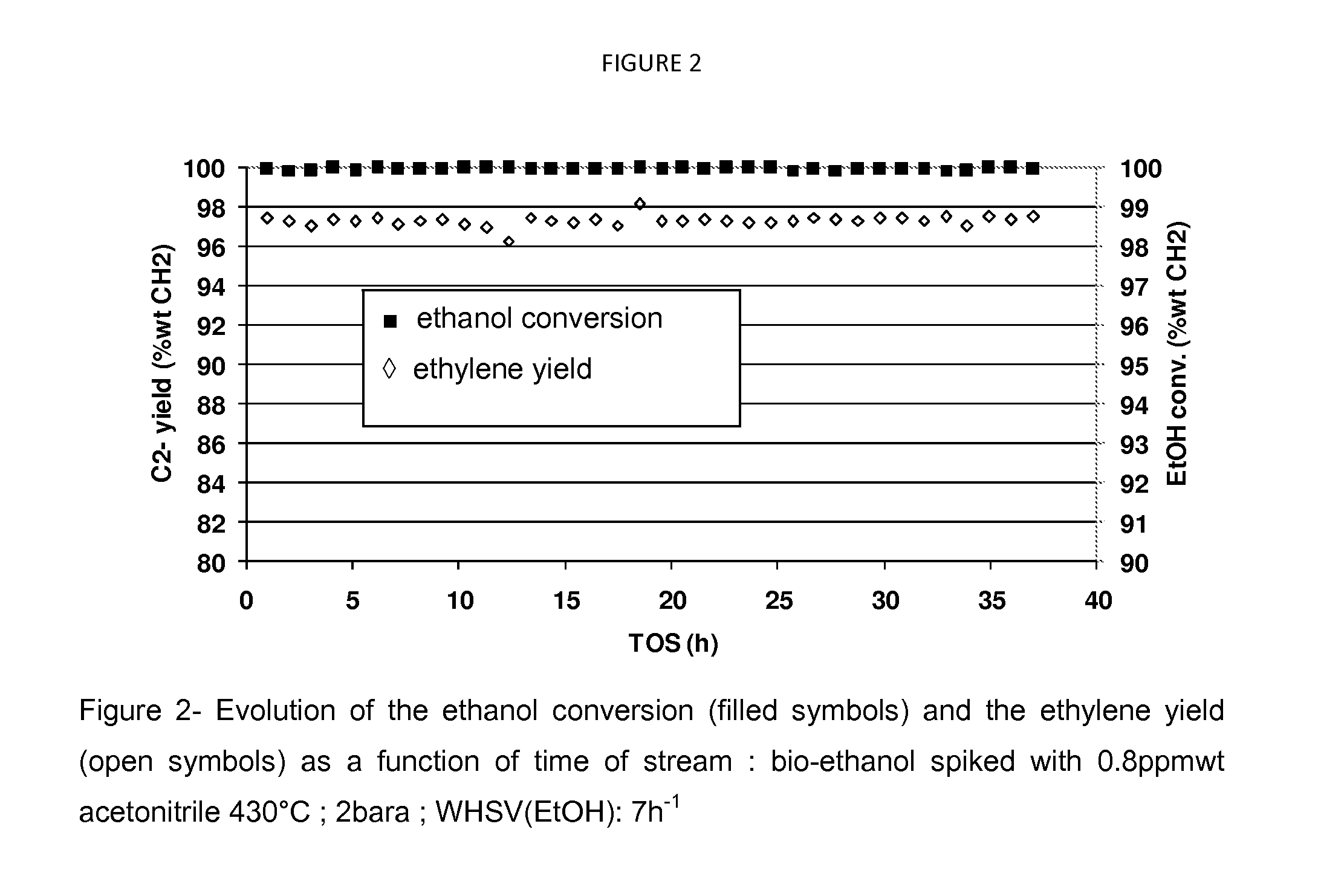Dehydration of alcohols on acidic catalysts
a catalyst and acidic technology, applied in the field of acidic catalyst dehydration of alcohols, can solve the problem of not having the means available to adjust the performance, and achieve the effect of reducing the adsorption equilibrium, reducing the poisoning of the catalyst, and optimal catalyst stability
- Summary
- Abstract
- Description
- Claims
- Application Information
AI Technical Summary
Benefits of technology
Problems solved by technology
Method used
Image
Examples
example 1
According to the Invention
[0124]In this example, the bio-ethanol (Surfin 96) has been spiked with 0.8 wppm acetonitrile. A mixture of 95% wt of the spiked ethanol and 5% wt water have been processed on the catalyst under the following dehydration conditions: outlet pressure of 2 bara, a weight hour space velocity referred to raw ethanol of 7 h−1, downflow. FIG. 2 shows the evolution of the ethanol conversion and the ethylene yield as a function of time on stream. The use of a controlled amount of neutralizing agent (in this case acetonitrile) allows to moderate the activity of the catalyst, therefore requiring a temperature increase (430° C. in this case), while improving the ethylene selectivity and without jeopardizing the time on stream performance as reported in table 3.
TABLE 3Performances of the dehydration catalyst at 430° C. under 2bara pressureusing bio-ethanol spiked with 0.8 ppm wt acetonitrile dilutedwith 5% wt water, the WHSV (ethanol) = 7 h−1.EtOH / H2O(95 / 5)% wtSpiked bi...
example 2
Comparative Example
[0125]In this example, the bio-ethanol used is the Surfin96 bio-ethanol.
[0126]A mixture of 95% wt Surfin96 bio-ethanol and 5% wt water have been processed on the catalyst under the following dehydration conditions: outlet pressure of 2 bara, a weight hour space velocity referred to Surfin96 bio-ethanol of 7 h−1, downflow, 430° C. FIG. 3 shows the evolution of the ethanol conversion (filled symbols) and the ethylene yield (open symbols) as a function of time on stream. Table 4 gathers the performances of the dehydration catalyst. The results show that when processing Surfin 96 bio-ethanol at 430° C., secondary reactions (oligomerization / cracking) occur and impact significantly the final ethylene selectivity.
TABLE 4Performances of the dehydration catalyst at 430° C. under 2bara outletpressure using Surfin 96 bio-ethanol diluted with 5% wt water,the WHSV (ethanol) = 7 h−1.EtOH / H2OFEED(95 / 5)% wtP (bara)2T (° C.)430WHSV (H−1)7EtOH conversion (% wt CH2)99.99DEE0.0Acetal...
PUM
| Property | Measurement | Unit |
|---|---|---|
| temperature | aaaaa | aaaaa |
| temperature | aaaaa | aaaaa |
| temperature | aaaaa | aaaaa |
Abstract
Description
Claims
Application Information
 Login to View More
Login to View More - R&D
- Intellectual Property
- Life Sciences
- Materials
- Tech Scout
- Unparalleled Data Quality
- Higher Quality Content
- 60% Fewer Hallucinations
Browse by: Latest US Patents, China's latest patents, Technical Efficacy Thesaurus, Application Domain, Technology Topic, Popular Technical Reports.
© 2025 PatSnap. All rights reserved.Legal|Privacy policy|Modern Slavery Act Transparency Statement|Sitemap|About US| Contact US: help@patsnap.com



